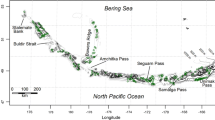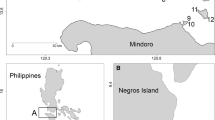Abstract
Classical sampling methods often miss important components of coral reef biodiversity, notably organisms that remain sheltered within the coral matrix. Recent studies using sea kraits (sea snakes) as bio-indicators suggest that the guild of predators represented by anguilliform fish (Congridae, Muraenidae, Ophichthidae, henceforth “eels” for simplicity) were far more abundant and diverse than previously suspected. In the current study, eel diversity (similarity and species richness indices) estimated via sea snake sampling (SSS) was compared among six areas of one of the main oceanic biodiversity hotspot of the Pacific Ocean (southwest lagoon of New Caledonia). Based on the eel diversity in the snakes’ diet, the results obtained in six areas, in two snake species, and using different estimates (ANOSIM, Shannon index…) were consistent, suggesting that SSS provided robust information. Analyses also suggested subtle, albeit significant, differences in the eel assemblages among islets. Such spatial differences are discussed in light of local management practices. As SSS is easy to use, cost-effective, and provides the best picture of eel assemblages to date, it can be employed to monitor the eel assemblages in addition to the snakes themselves in many areas of the Indo-Pacific Ocean, thereby providing an index of the top predator biodiversity of many coral reefs.



Similar content being viewed by others
References
Abrams RW, Abrams MD, Schein MW (1983) Diurnal observations on the behavioral ecology of Gymnothorax moringa (Cuvier) and Muraena miliaris (Kaup) on a Caribbean coral reef. Coral Reefs 1:185–192
Andréfouët S, Torres-Pulliza D (2004) Atlas des récifs coralliens de Nouvelle-Calédonie, IFRECOR Nouvelle-Calédonie. IRD, Nouméa, p 48
Bellwood DR, Hughes TP, Folke C, Nyström M (2004) Confronting the coral reef crisis. Nature 429:827–833
Bonnet X, Brischoux F, Pearson D, Rivalan P (2009) Beach-rock as a keystone habitat for sea kraits. Environ Conserv 36:62–70
Brischoux F, Bonnet X (2008) Estimating the impact of sea kraits on the anguilliform fish community (Muraenidae, Congridae, Ophichthidae) of New Caledonia. Aquat Liv Res 21:395–399
Brischoux F, Bonnet X (2009) Life history of sea kraits in New Caledonia. Zoologia Neocaledonica 7. Mém Mus Nat Hist Nat 198:37–51
Brischoux F, Bonnet X, De Crignis M (2007a) A method to reconstruct anguilliform fishes from partially digested items. Mar Biol 151:1893–1897
Brischoux F, Bonnet X, Shine R (2007b) Foraging ecology of sea kraits (Laticauda spp.) in the Neo-Caledonian lagoon. Mar Ecol Prog Ser 350:145–151
Brischoux F, Bonnet X, Shine R (2009a) Determinants of dietary specialization: a comparison of two sympatric species of sea snakes. Oikos 118:145–151
Brischoux F, Bonnet X, Pinaud D (2009b) Fine scale site fidelity in sea kraits: implications for conservation. Biodivers Conserv (in press)
Chapman MG, Underwood AJ (1999) Ecological patterns in multivariate assemblages: information and interpretation of negative values in ANOSIM tests. Mar Ecol Prog Ser 180:257–265
Cherel Y, Duhamel G, Gasco N (2004) Cephalopod fauna of subantarctic islands: new information from predators. Mar Ecol Prog Ser 266:143–156
Cherel Y, Sabatié R, Potier M, Marsac F, Ménard F (2007) New information from fish diets on the importance of glassy flying squid (Hyaloteuthis pelagica) (Teuthoidea: Ommastrephidae) in the epipelagic cephalopod community of the tropical Atlantic Ocean. Fish Bull 105:147–152
Clarke KR (1993) Non-parametric multivariate analysis of changes in community structure. Aust J Ecol 18:117–143
Cogger H, Heatwole H (2006) Laticauda frontalis (de Vis, 1905) and Laticauda saintgironsi n.sp. from Vanuatu and New Caledonia (Serpentes: Elapidae: Laticaudinae)—a new lineage of sea kraits? Rec Aust Mus 58:245–256
Colwell RK (2005) EstimateS: statistical estimation of species richness and shared species from samples. Version 7.5. Presistent URL<purl.oclc.org/estimates>
Froese R, Pauly D (eds) (2006) FishBase. World Wide Web electronic publication. www.fishbase.org, version 12/2006
Guinotte JM, Buddemeier RW, Kleypas JA (2003) Future coral reef habitat marginality: temporal and spatial effects of climate change in the Pacific basin. Coral Reefs 22:551–558
Heatwole H (1999) Sea snakes Australian natural history series. University of New South Wales, Australia
Heatwole H, Busack S, Cogger H (2005) Geographic variation in sea kraits of the Laticauda colubrina complex (Serpentes: Elapidae: Hydrophiinae: Laticaudini). Herpetol Monogr 19:1–136
Hindell MA, Bradshaw CJA, Harcourt RG, Guinet C (2003) Ecosystem monitoring: are seals a potential tool for monitoring change in marine systems? In: Gales NJ, Hindell MA, Kirkwood R (eds) Marine mammals. Fisheries, tourism and management issues. CSIRO Publishing, Melbourne, pp 330–343
Hochberg EJ, Atkinson MJ, Andrefouet S (2003) Spectral reflectance of coral reef bottom-types worldwide and implications for coral reef remote sensing. Remote Sens Environ 85:159–173
Hughes TP (1994) Catastrophes, phase-shifts, and large-scale degradation of a Caribbean coral-reef. Science 265:1547–1551
Ineich I, Laboute P (2002) Sea snakes of New Caledonia. IRD et Muséum national d’Histoire naturelle Editions, Collection Faune et flore tropicales, Paris
Ineich I, Bonnet X, Brischoux F, Kulbicki M, Séret B, Shine R (2007) Anguilliform fishes and sea kraits: neglected predators in coral reef ecosystems. Mar Biol 151:793–802
Kitahara M, Fujii K (1994) Biodiversity and community structure of temperate butterfly species within a gradient of human disturbance: an analysis based on the concept of generalist vs. specialist strategies. Pop Ecol 36:187–199
Koellner T, Hersperger AM, Wohlgemuth T (2004) Rarefaction method for assessing plant species diversity on a regional scale. Ecography 27:532–544
Kulbicki M (1997) Bilan de 10 ans de recherche (1985–1995) par l’ORSTOM sur la structure des communautés des poisons lagonaires et récifaux en Nouvelle-Calédonie. Cybium 21:47–79
Magurran AE (1988) Ecological diversity and its measurement. Croom Helm Ltd, London, UK
McGeoch M (1998) The selection, testing and application of terrestrial insects as bioindicators. Biol Rev 73:181–201
Ménard F, Potier M, Romanov E, Jaquemet S, Sabatié R, Cherel Y (2007) New information from predator diets on the importance of two Ommastrephidae: Sthenoteuthis oualaniensis in the Indian Ocean and Hyaloteuthis pelagica in the Atlantic Ocean. GLOBEC Report 24:49–52
Niemelä J (2000) Biodiversity monitoring for decision-making. Ann Zool Fenn 37:307–317
Noss RF (1990) Indicators for monitoring biodiversity: a hierarchical approach. Conserv Biol 4:355–364
Pandolfi JM, Bradbury RH, Sala E, Hughes TP, Bjorndal KA, Cooke RG, McArdle D, McClenachan L, Newman MJH, Paredes G, Warner RR, Jackson JBC (2003) Global trajectories of the long-term decline of coral reef ecosystems. Science 301:955–958
Pearson DL, Cassola F (1992) World-wide species richness patterns of tiger beetles (Coleoptera: Cicindelidae): indicator taxon for biodiversity and conservation studies. Conserv Biol 6:376–391
Reed RN, Shine R, Shetty S, Cogger H (2002) Sea kraits (Squamata: Laticauda spp.) as a useful bioassay for assessing local diversity of eels (Muraenidae, Congridae) in the western Pacific Ocean. Copeia 2002:1098–1101
Rogers CS (1990) Responses to coral reefs and reef organisms to sedimentation. Mar Ecol Prog Ser 62:185–202
Saint Girons H (1964) Notes sur l’écologie et la structure des populations des Laticaudinae (Serpentes : Hydrophiidae) en Nouvelle-Calédonie. Rev Ecol 111:185–214
Séret B, Brischoux F, Bonnet X, Shine R (2008) First record of Cirrimaxilla formosa (Teleostei: Muraenidae) from New Caledonia, found in sea snake stomach contents. Cybium 32:191–192
Sheppard CRC (2003) Predicted recurrences of mass coral mortality in the Indian Ocean. Nature 425:294–297
Shetty S, Shine R (2002a) Sexual divergence in diets and morphology in Fijian sea snakes, Laticauda colubrina (Laticaudidae). Aust Ecol 27:77–84
Shetty S, Shine R (2002b) Philopatry and homing behavior of sea snakes (Laticauda colubrina) from two adjacent islands in Fiji. Conserv Biol 16:1422–1426
Shine R, Reed RN, Shetty S, Cogger HG (2002) Relationships between sexual dimorphism and niche partitioning within a clade of sea-snakes (Laticaudinae). Oecologia 133:45–53
Su Y, Fong S-C, Tu M-C (2005) Food habits of the Sea Snake Laticauda semifasciata. Zool Stud 44:403–408
Vitousek PM, Mooney HA, Lubchenco J, Melillo JM (1997) Human domination of earth’s ecosystems. Science 277:494–499
Wantiez L, Thollot P, Kulbicki M (1997) Effects of marine reserves on coral reef fish communities from five islands in New Caledonia. Coral Reefs 16:215–224
Wilkinson C (2006) Status of coral reefs of the world: summary of threats and remedial action. In: Coté IM, Reynolds JD (eds) Coral reefs conservation. Cambridge University Press. CSIRO Publishing, Melbourne, pp 3–39
Acknowledgments
B. Seret and R. Cambag helped with eel identifications. I. Ineich, Mayol, A. Lane, O. Lourdais, S. Lorioux, M. De Crignis, D. Pearson, A. Ramirez, M. Guillon, C. Michel, D. Serin, M. Bonnet and A. Lavandier helped during fieldwork. T. Cook and R. Tingley corrected the English. We also thank C. Chevillon, B. Mège, C. Goiran, and D. Ponton (DRN Province Sud, CONCEPT, Aquarium de Nouméa, IRD) for logistical support. We thank the Centre National de la Recherche Scientifique, and the University François Rabelais for funding. The study was carried out under permits #6024-179/DRN/ENV and #6024-3601/DRN/ENV.
Author information
Authors and Affiliations
Corresponding author
Additional information
Communicated by S. A. Poulet.
Appendix 1
Appendix 1
See Table 2.
Rights and permissions
About this article
Cite this article
Brischoux, F., Bonnet, X. & Legagneux, P. Are sea snakes pertinent bio-indicators for coral reefs? a comparison between species and sites. Mar Biol 156, 1985–1992 (2009). https://doi.org/10.1007/s00227-009-1229-7
Received:
Accepted:
Published:
Issue Date:
DOI: https://doi.org/10.1007/s00227-009-1229-7




